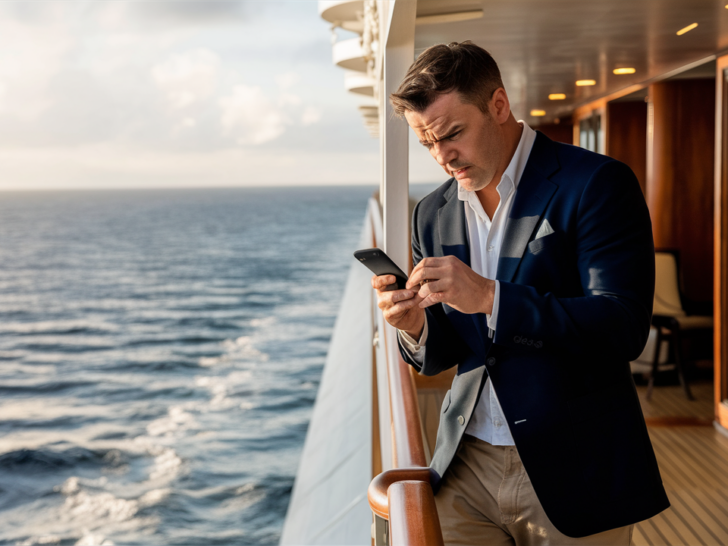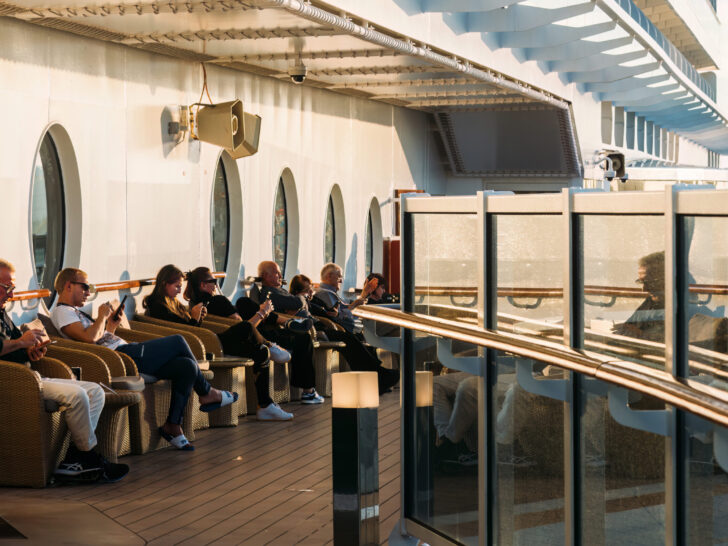Today’s smartphones and tablets have become indispensable, offering convenience, efficiency, and endless entertainment. However, when you board a cruise ship, these digital companions can quickly turn from helpful tools into sources of frustration if not managed properly.
Just as you pack your suitcase carefully, preparing your tech devices for the voyage can save you from unexpected hassles and keep your cruise experience smooth and enjoyable.
Here’s a collection of sanity-saving tips to ensure your phones and tablets enhance your cruise experience rather than detract from it.

1. Beware Automatic Clock Resets 🕰️
When on land, automatic clock resets are a lifesaver. But at sea, they can cause confusion. The GPS systems that allow your phone to auto reset to local time everywhere in the world don’t seem to work right at sea.
Turn off automatic time changes to avoid syncing issues with “ship time.”
2. Turn off all alarms 🔕
Disabling automatic time resets isn’t enough. To avoid unwelcome wake-up calls, turn off regular alarms. Do this even if you disable automatic time resets. As noted above, the auto time can get screwy when you are on the ocean. And, even if the clock seems to be right when you go to bed, time gremlins seem to come out to play at night while you sleep.
To avoid you and everyone else in your cabin being blared awake at 3:00 in the morning, turn off the alarm on your phone or other electronic devices. Use the ship’s wake-up call service or a non-GPS alarm clock for a reliable wake-up.
3. Bring a Backup Power Source 🔋
Your battery consumption may skyrocket on a cruise.
Your battery consumption may increase significantly compared to your typical consumption at home. In addition to your usual power-saving measures, carry a portable charger.
Even if you never run into consumption issues at home, many things can substantially increase your power consumption. For instance, if you are using your phone or tablet as a camera or shooting videos, or if your device is constantly trying to access a Wi-Fi network and failing.
4. Safeguard Downloaded Content 📥
Be aware that your previously downloaded content may become inaccessible when you’re traveling due to licensing issues or locality restrictions. The quickest and easiest way to prevent that is to turn off Wi-Fi on your primary viewing device before you set sail and leave it off until you return home. That way, your device will not register that you have left the country (as it would if you connected to Wi-Fi).
Note that the locality issue can kick in with content downloaded from any and every service—Amazon, Netflix, Hulu, etc. This means certain movies and televisions have restricted viewing rights outside the U.S. or in specific countries. These restrictions may even apply to content that you purchased.
It can be extraordinarily frustrating to take the time to download hours of content for all family members and then not be able to use it when you most need it.

5. Data Roaming and Cellular Service 🌐
Turn off data roaming to avoid surprise charges. Don’t assume that your international plan will apply on a cruise. Even with an international plan, data roaming at sea can be costly. Check for cruise-specific rules and packages from your carrier.
6. Managing Notifications 🔕
Before boarding, silence all non-essential notifications. Cruise ship activities and excursions can keep you busy, and constant notifications can be both a distraction and a battery drain.
7. Utilizing Airplane Mode ✈️
Keep your device in airplane mode to prevent it from searching for cellular signals constantly. This will save battery and prevent unexpected charges. You can still enable Wi-Fi while in airplane mode to use the ship’s network.
8. Backup and Storage ☁️
Before leaving home, make sure all important data (photos, documents, etc.) are backed up to the cloud. This prevents loss in case of device failure and frees up space for new vacation photos and videos.
9. Update Your Roster of Applications 📲
Pre-download Ship’s App. Many cruise lines offer apps with daily schedules, dining menus, and ship maps. Download and set up these apps before boarding to save time and reduce initial data use.
Limit Background Apps. Close or restrict background applications that may consume data or battery life. Apps like email or social media can continuously sync and drain your battery.
10. Helpful Items to Download 📚
Offline Maps and Guides. Download offline maps and travel guides of your destinations. This can be particularly useful when exploring ports without needing a data connection.
E-Books and Audiobooks. Pre-download a selection of e-books and audiobooks. These are perfect for relaxing by the pool or during downtime without needing an internet connection.
11. Device Security 🔒
Enable Security Features. Set up and enable security features such as fingerprint recognition or face ID. This provides added security if your device is lost or stolen.
Use a Waterproof Case. Invest in a good-quality waterproof case for your devices. This will protect them from splashes at the pool or beach excursions.
Closing Thoughts
By managing your devices proactively, you can ensure that your cruise is filled with relaxation and adventure rather than tech-related stress. From safeguarding your content and optimizing battery life to avoiding unwanted charges and securing your devices, these strategies will help keep your cruise experience smooth and enjoyable.

Elaine Warren
Founder & Crew Chief
Elaine founded this website after publishing the book The Family Cruise Companion’s Guide to Cruising With Kids. (Second edition recently released!) She has sailed on 45 cruises (and counting). She loves helping families navigate their way to an adventure-filled, fun, and memorable vacation.

